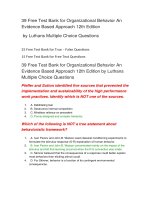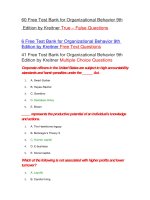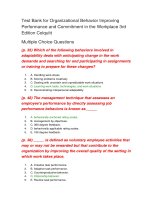Test bank managing organizational change 3rd ch1
Bạn đang xem bản rút gọn của tài liệu. Xem và tải ngay bản đầy đủ của tài liệu tại đây (170.1 KB, 91 trang )
Chapter 01
Managing Change: Stories and Paradoxes
Multiple Choice Questions
1. Which of the following statements is a characteristic of process narratives?
A.
B.
C.
D.
They are based on quantitative and statistical research methods.
They have a narrow frame of reference.
They lack the ability to express complexity within a coherent sequence of even
They expose the nature and significance of the causal factors acting on event
2. Which of the following major problems did Beth Israel Deaconess Medical Center
(BID) face in 2002?
A.
B.
C.
D.
A lawsuit attempting to dissolve the center
Poor relationships between clinical staff and management
Employees fearing job cuts as a result of the merger of Beth Israel and Deacones
A corporate takeover attempt by a competitor
3. Which of the following turnaround strategies was adopted by Paul Levy, the chief
executive officer of the Beth Israel Deaconess Medical Center (BID), in 2002?
A.
B.
C.
D.
He ensured that there were no job cuts.
He shared with all staff the full scale of the financial difficulties.
He promoted silo working within the organization.
He encouraged the different departments to focus exclusively on their own profi
4. According to Paul Levy, which of the following will drive doctors, nurses, and
administrators to seek constant improvements in the quality and safety of patient
care?
A.
B.
C.
D.
A silo working environment
A rigid, hierarchical organizational structure
The transparency website
The fear of job cuts among employees
1-1
Copyright © 2017 McGraw-Hill Education. All rights reserved. No reproduction or distribution without the prior written consent of
McGraw-Hill Education.
5. Identify the major problem faced by Sears Holdings Corporation two years after the
merger of Kmart and Sears Roebuck.
A.
B.
C.
D.
A lawsuit alleging environmental damage was filed by regulators.
A lawsuit to dissolve the merger was filed.
Profits were down by 45 percent.
Problems existed with the quality and safety of customer care.
6. Which of the following is one of the steps taken by Eddie Lampert in response to the
problems faced by Sears Holdings Corporation?
A.
B.
C.
D.
He published performance data on his public blog.
He implemented a business model in which all department heads had the same fin
He downsized the company.
He implemented a decentralized organizational structure.
7. Which of the following was the outcome of the new organizational model
implemented by Eddie Lampert, the chairman of Sears Holdings Corporation?
A.
B.
C.
D.
It improved performance.
It encouraged the divisions to turn against each other.
It resulted in several hundred job losses across the organization.
It encouraged the department heads to focus on the welfare of the company as
8. In 2011, 50 to 70 percent of all sales in J. C. Penney Company, Inc. were discounted,
based on a _____.
A.
B.
C.
D.
"high-low" pricing strategy
quantity-based pricing strategy
premium pricing strategy
value-based pricing strategy
9. Which of the following was a step taken by Ron Johnson when he was appointed as
the chief executive officer of J. C. Penney Company, Inc.?
A.
B.
C.
D.
He reinforced the existing corporate culture.
He implemented a centralized organizational structure.
He developed a "store within a store" strategy.
He increased promotions in the company's stores.
1-2
Copyright © 2017 McGraw-Hill Education. All rights reserved. No reproduction or distribution without the prior written consent of
McGraw-Hill Education.
10. According to an analyst referred to in the text, which of the following was missing
when Ron Johnson, the chief executive officer of J. C. Penney Company, Inc., talked
about the six Ps?
A.
B.
C.
D.
11. Which of the following is the first and most serious mistake committed by Ron
Johnson, the chief executive officer of J. C. Penney Company, Inc.?
A.
B.
C.
D.
Creating a silo work environment in the company
Ignoring the company's traditional core customers
Downsizing the company
Decentralizing the company's organizational structure
12. Which of the following features of the literature on change management makes it
difficult to access and to absorb?
A.
B.
C.
D.
All the literature on change share the same perspective.
Recent work has made previous commentary irrelevant.
The literature on change lacks variety in terms of methodologies.
The concepts that are used range in scale.
13. Which of the following is a characteristic of organizational change?
A.
B.
C.
D.
It is a completely irrational process.
From a management perspective, it is easy to implement.
From a management perspective, it is seen as problematic.
It is a process that lacks creativity.
14. Which of the following is most likely an advantage of adopting a multiple
perspectives approach to the management of organizational change?
A.
B.
C.
D.
It results in the easy access to the change literature.
It encourages the search for creative solutions.
It overcomes the issue of fragmented advice.
It provides solutions that are agreed upon by all the experts.
1-3
Copyright © 2017 McGraw-Hill Education. All rights reserved. No reproduction or distribution without the prior written consent of
McGraw-Hill Education.
15. Which of the following reasons makes it difficult for a practicing manager who is less
interested in theoretical perspectives to know what works in the management of
organizational change?
A.
B.
C.
D.
The impact of change is unidimensional.
The cause and effect across complex processes that unfold over time is difficult to
The stakeholders affected by change share the same view.
The recent work has made previous commentary on change management irrele
16. Which of the following statements is true of organizational change?
A.
B.
C.
D.
Minor changes are less valuable.
The importance of minor changes is overstated in organizations.
The implementation of minor changes is relatively expensive.
Shallower changes can facilitate and complement the deeper initiatives.
17. According to research evidence, which of the following management styles is likely to
be more open to change?
A.
B.
C.
D.
A casual management style
A bureaucratic management style
A top-down management style
A rules-based management style
18. Based on research evidence, top-down management and rules-based management
styles suggest that:
A.
B.
C.
D.
change is dependent on due process and committee cycles.
the organization implementing change is responsive.
change will be rapid
the organization implementing change is more agile.
19. In the context of different cultures in organizations, skilled change agents are most
likely to struggle in _____.
A.
B.
C.
D.
casual style-based organizations
responsive organizations
rules-based organizations
20. Which of the following statements is true of active learning?
A.
B.
C.
D.
It occurs only in organizations with rules-based, top-down management.
It refers to implementing changes.
It automatically follows the process of identifying lessons after a crisis.
It occurs only when change is a solo performance.
1-4
Copyright © 2017 McGraw-Hill Education. All rights reserved. No reproduction or distribution without the prior written consent of
McGraw-Hill Education.
21. In the context of assessing depth of change, which of the following is an example of
change that is categorized as "off the scale"?
A.
B.
C.
D.
Improving efficiencies
Changing the way in which business transactions are conducted
Dramatically redrawing organization and sector boundaries
Relocating resources
22. In the context of assessing depth of change, which of the following is an example of
deeper change?
A.
B.
C.
D.
Identifying new ways of doing business
Resolving an organization's minor problems
Improving efficiencies
23. In the context of assessing depth of change, which of the following is an example of
"not on the scale" changes?
A.
B.
C.
D.
The processes for relocating resources
The processes for cutting costs
24. In the context of assessing depth of change, _____ involves improving on current
practices in organizations.
A.
B.
C.
D.
frame-breaking change
disrupting innovation
sustaining innovation
25. In the context of assessing depth of change, which of the following changes falls at
the top of the scale?
A.
B.
C.
D.
Sustaining innovation
Disruptive innovation
1-5
Copyright © 2017 McGraw-Hill Education. All rights reserved. No reproduction or distribution without the prior written consent of
McGraw-Hill Education.
26. In the context of assessing depth of change, _____ involves radically new business
models and working methods.
A.
B.
C.
D.
sustaining innovation
disruptive innovation
27. Which of the following statements is true of transformational "off the scale"
changes?
A.
B.
C.
D.
They are usually easier to implement than deep changes.
They are more challenging than shallow changes.
When assessing the depth of change, they fall in the middle of the scale.
When assessing the depth of change, they are at the bottom of the scale.
28. Which of the following changes is most likely to create greater resistance?
A.
B.
C.
D.
Transformational "not on the scale" changes
Transformational "off the scale" changes
True / False Questions
29. Process theories lack the ability to reveal the mechanisms or logics behind a
sequence of events.
True
False
30. Changing organizations is as messy as it is exhilarating, as frustrating as it is
satisfying, as muddling-through and creative a process as it is a rational one.
True
False
31. Paul Levy's turnaround strategy in the Beth Israel Deaconess Medical Center (BID)
was based on two themes: transparency and commitment to quality.
True
False
32. Paul Levy, the chief executive officer of the Beth Israel Deaconess Medical Center
(BID), promoted a silo working environment.
True
False
1-6
Copyright © 2017 McGraw-Hill Education. All rights reserved. No reproduction or distribution without the prior written consent of
McGraw-Hill Education.
33. Eddie Lampert, the chairman of Sears Holdings Corporation, restructured the
company as a classic retailer.
True
False
34. The reorganization of Sears Holdings Corporation under its chairman, Eddie Lampert,
resulted in better collaboration and cooperation among various department heads.
True
False
35. Most estimates put the failure rate of planned changes at around 98 percent.
True
False
36. Accounts of how other organizations have handled change can be a rich source of
ideas that can be adapted creatively to address similar problems in other settings.
True
False
37. Change is a political process because there are often "winners and losers."
True
False
38. It is best to use shallow changes to address strategic challenges.
True
False
1-7
Copyright © 2017 McGraw-Hill Education. All rights reserved. No reproduction or distribution without the prior written consent of
McGraw-Hill Education.
Chapter 01 Managing Change: Stories and Paradoxes Answer
Key
Multiple Choice Questions
1-8
Copyright © 2017 McGraw-Hill Education. All rights reserved. No reproduction or distribution without the prior written consent of
McGraw-Hill Education.
1.
Which of the following statements is a characteristic of process narratives?
A
Th
.ey
ar
e
ba
se
d
on
qu
an
tit
ati
ve
an
d
st
ati
sti
cal
re
se
ar
ch
m
et
ho
ds
.
B
Th
.ey
ha
ve
a
na
rro
w
fra
m
e
of
ref
er
en
ce
.
1-9
Copyright © 2017 McGraw-Hill Education. All rights reserved. No reproduction or distribution without the prior written consent of
McGraw-Hill Education.
C
Th
.ey
lac
k
th
e
ab
ilit
y
to
ex
pr
es
s
co
m
pl
exi
ty
wi
thi
n
a
co
he
re
nt
se
qu
en
ce
of
ev
en
ts.
1-10
Copyright © 2017 McGraw-Hill Education. All rights reserved. No reproduction or distribution without the prior written consent of
McGraw-Hill Education.
D
Th
.ey
ex
po
se
th
e
na
tur
e
an
d
sig
ni
fic
an
ce
of
th
e
ca
us
al
fa
ct
or
s
ac
tin
g
on
ev
en
ts.
Accessibility: Keyboard Navigation
Difficulty: 2 Medium
Learning Objective: 01-01 Understand how stories of change can contribute to our knowledge of theory and
practice.
Learning Objective: 01-02 Explain why managing organizational change is both a creative and a rational
process.
1-11
Copyright © 2017 McGraw-Hill Education. All rights reserved. No reproduction or distribution without the prior written consent of
McGraw-Hill Education.
1-12
Copyright © 2017 McGraw-Hill Education. All rights reserved. No reproduction or distribution without the prior written consent of
McGraw-Hill Education.
2.
Which of the following major problems did Beth Israel Deaconess Medical Center
(BID) face in 2002?
A
A
.la
ws
uit
att
e
m
pti
ng
to
di
ss
ol
ve
th
e
ce
nt
er
B
Po
.or
rel
ati
on
shi
ps
be
tw
ee
n
cli
ni
cal
st
aff
an
d
m
an
ag
e
m
en
t
1-13
Copyright © 2017 McGraw-Hill Education. All rights reserved. No reproduction or distribution without the prior written consent of
McGraw-Hill Education.
C
E
.m
pl
oy
ee
s
fe
ari
ng
jo
b
cu
ts
as
a
re
sul
t
of
th
e
m
er
ge
r
of
Be
th
Isr
ae
l
an
d
De
ac
on
es
s
Ho
spi
tal
1-14
Copyright © 2017 McGraw-Hill Education. All rights reserved. No reproduction or distribution without the prior written consent of
McGraw-Hill Education.
D
A
.co
rp
or
at
e
ta
ke
ov
er
att
e
m
pt
by
a
co
m
pe
tit
or
Accessibility: Keyboard Navigation
Difficulty: 2 Medium
Learning Objective: 01-01 Understand how stories of change can contribute to our knowledge of theory and
practice.
1-15
Copyright © 2017 McGraw-Hill Education. All rights reserved. No reproduction or distribution without the prior written consent of
McGraw-Hill Education.
1-16
Copyright © 2017 McGraw-Hill Education. All rights reserved. No reproduction or distribution without the prior written consent of
McGraw-Hill Education.
3.
Which of the following turnaround strategies was adopted by Paul Levy, the chief
executive officer of the Beth Israel Deaconess Medical Center (BID), in 2002?
A
He
.en
su
re
d
th
at
th
er
e
w
er
e
no
jo
b
cu
ts.
B
He
.sh
ar
ed
wi
th
all
st
aff
th
e
ful
l
sc
al
e
of
th
e
fin
an
cia
l
di
ffi
cu
lti
es.
1-17
Copyright © 2017 McGraw-Hill Education. All rights reserved. No reproduction or distribution without the prior written consent of
McGraw-Hill Education.
C
He
.pr
o
m
ot
ed
sil
o
wo
rki
ng
wi
thi
n
th
e
or
ga
niz
ati
on
.
1-18
Copyright © 2017 McGraw-Hill Education. All rights reserved. No reproduction or distribution without the prior written consent of
McGraw-Hill Education.
D
He
.en
co
ur
ag
ed
th
e
di
ffe
re
nt
de
pa
rt
m
en
ts
to
fo
cu
s
ex
clu
siv
ely
on
th
eir
ow
n
pr
ofi
ta
bili
ty.
Accessibility: Keyboard Navigation
Difficulty: 2 Medium
Learning Objective: 01-01 Understand how stories of change can contribute to our knowledge of theory and
practice.
1-19
Copyright © 2017 McGraw-Hill Education. All rights reserved. No reproduction or distribution without the prior written consent of
McGraw-Hill Education.
1-20
Copyright © 2017 McGraw-Hill Education. All rights reserved. No reproduction or distribution without the prior written consent of
McGraw-Hill Education.
4.
According to Paul Levy, which of the following will drive doctors, nurses, and
administrators to seek constant improvements in the quality and safety of patient
care?
A
A
.sil
o
w
or
ki
ng
en
vir
on
m
en
t
B
A
.rig
id,
hi
er
ar
ch
ic
al
or
ga
ni
za
tio
na
l
str
uc
tur
e
C
Th
.e
tr
an
sp
ar
en
cy
w
eb
sit
e
1-21
Copyright © 2017 McGraw-Hill Education. All rights reserved. No reproduction or distribution without the prior written consent of
McGraw-Hill Education.
D
Th
.e
fe
ar
of
jo
b
cu
ts
a
m
on
g
e
m
pl
oy
ee
s
Accessibility: Keyboard Navigation
Difficulty: 1 Easy
Learning Objective: 01-01 Understand how stories of change can contribute to our knowledge of theory and
practice.
1-22
Copyright © 2017 McGraw-Hill Education. All rights reserved. No reproduction or distribution without the prior written consent of
McGraw-Hill Education.
1-23
Copyright © 2017 McGraw-Hill Education. All rights reserved. No reproduction or distribution without the prior written consent of
McGraw-Hill Education.
5.
Identify the major problem faced by Sears Holdings Corporation two years after
the merger of Kmart and Sears Roebuck.
A
.la
ws
uit
all
eg
in
g
en
vir
on
m
en
tal
da
m
ag
e
wa
s
fil
ed
by
re
gu
lat
or
s.
B
A
.la
ws
uit
to
di
ss
ol
ve
th
e
m
er
ge
r
w
as
fil
ed
.
1-24
Copyright © 2017 McGraw-Hill Education. All rights reserved. No reproduction or distribution without the prior written consent of
McGraw-Hill Education.
C
Pr
.ofi
ts
w
er
e
do
w
n
by
45
pe
rc
en
t.
D
Pr
.ob
le
m
s
ex
ist
ed
wi
th
th
e
qu
ali
ty
an
d
sa
fet
y
of
cu
st
o
m
er
ca
re.
Accessibility: Keyboard Navigation
Difficulty: 1 Easy
Learning Objective: 01-01 Understand how stories of change can contribute to our knowledge of theory and
practice.
1-25
Copyright © 2017 McGraw-Hill Education. All rights reserved. No reproduction or distribution without the prior written consent of
McGraw-Hill Education.









